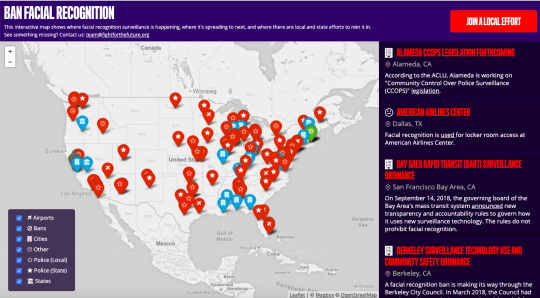NEW: Fight for the Future launches interactive facial recognition map as part of nationwide campaign for local and state level bans
FOR IMMEDIATE RELEASE: July 18, 2019
Contact: Evan Greer, 978-852-6457, press@fightforthefuture.org

Fight for the Future just launched a first-of-its-kind interactive map that tracks where in the U.S. facial recognition technology is being used and where it is being resisted, and a tool-kit for local activists who want to help kickstart a ban in their city or state.
This is a major new phase of our BanFacialRecognition.com campaign: a nationwide push to kickstart more local- and state-level efforts to ban facial recognition surveillance.
The map includes known locations where:
- Scans of driver’s license photos and mug shots by law enforcement are reported to be taking place
- Facial recognition has begun to invade stores, stadiums, and airports
- Amazon Ring has formed surveillance partnerships with local police (first time this list has been published)
- Pioneering city bans on facial recognition have been or may soon be passed
- Statewide moratoriums on facial recognition are being considered
- Surveillance ordinances that govern procurement processes have been passed
- US senators and representatives have formally issued oversight letters expressing concern over unethical uses of surveillance technology
It’s nearly impossible to create an exhaustive list given the secrecy surrounding the use of facial recognition surveillance, but we’ve compiled a robust list of use cases that have been publicly reported. We’ll be crowdsourcing this information and updating the map as new information surfaces.
Evan Greer (she/her), Digital Rights Campaign Director at Fight for the Future, sees these local actions—which enjoy overwhelming popular support—as part of a growing movement. The campaign calling for a ban on facial recognition echoes academics who have studied facial recognition technology and likens it to the proliferation of nuclear or biological weapons. “Imagine if we could go back in time and prevent governments around the world from ever building nuclear or biological weapons. That’s the moment in history we’re in right now with facial recognition.”
We are on the verge of an unprecedented increase in state and private spying that will be built in plain sight. People are alarmed, and this map and the toolkit arms people everywhere with the resources to both fight back and learn from how others are doing it. It’s going to take all of us to rid this country of this most dangerous technology.
“We’re seeing growing momentum across the country of people pushing back against this dangerous technology, and we wanted to provide a useful resource to put all this information together.” said Evan Greer (she/her), a campaign director at Fight for the Future. San Francisco,Somerville, MA, and Oakland, CA, recently became the first cities in the country to ban the technology. Berkeley is also considering a ban, and bills to halt current use of the tech are before the Massachusetts and Michigan legislatures. In Congress, there is growing bipartisan agreement to address the issue, but it could easily stall under pressure from law enforcement and big tech.
This is a bipartisan issue. At a congressional hearing in June, Democrat Alexandria Ocasio-Cortez and Republican Jim Jordan agreed that the technology poses a clear threat. Arguing that the technology will turn George Orwell’s dystopian novel 1984 into a disturbing reality, Jordan said, “Doesn’t matter what side of the political spectrum you’re on, this should concern us all.”
The Washington Post reported last week that the FBI and ICE have secretly accessed millions of American’s driver’s license photos as part of a nationwide facial recognition dragnet, turning DMV databases “into the bedrock of an unprecedented surveillance infrastructure.”
Last month, Axon, one of the largest suppliers of police body cameras in America, announced it would not equip its products with facial recognition, saying it could not “ethically justify” doing so. Prior to the company’s decision, several studies uncovered extensive inaccuracies in the technology and embedded biases against women and people of color.

